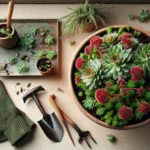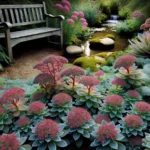Introduction to Sedum Rubrotinctum
Welcome to the world of Sedum rubrotinctum, the vibrant succulent that’s stealing the show in modern homes! This little plant is anything but ordinary. With its plump, glossy leaves that blush red in the sun, it’s a living piece of art that’s easy to care for and hard to overlook. Whether nestled on a sunny windowsill or adding panache to a green roof, this succulent is a botanical treasure, and here’s why.
Succulent enthusiasts, you’re in for a treat! The Sedum rubrotinctum, affectionately known as ‘Jelly Bean Plant’ or ‘Pork and Beans,’ has become a must-have in any collection. Imagine this: You’ve got guests over, and amidst the usual chit-chat, their eyes land on your display of Sedum rubrotinctum. It’s the perfect conversation starter with its quirky charm. “Is that a plant or a bowl of candies?” they wonder aloud, impressed by nature’s playful side. It’s not just a plant—it’s a statement.
If you’re curious about how this succulent can enhance your living space, take a look at this video that delves into care tips for the Jelly Beans plant:
But Sedum rubrotinctum isn’t just another pretty face in the crowd of succulents. It’s a resilient and forgiving plant, thriving with minimal attention, which makes it an excellent choice for busy homeowners or those new to the plant world. It’s the kind of green buddy that won’t hold a grudge if you forget to water it for a bit. That’s right, it’ll just keep on thriving, making it a symbol of resilience and adaptability.
Seeking more ways to inspire your green thumb? Take a journey across our website and explore our guide on indoor succulent plants—it’s a treasure trove of tips tailored to elevating your home’s aesthetic with these low-maintenance beauties.
From the effortless propagation that even a novice gardener can master to the easy-going nature that fits right into the hustle and bustle of contemporary life, Sedum rubrotinctum is the green gem that keeps on giving. So why not invite this plump-leaved charmer into your space and watch as it transforms your home into a vibrant, living canvas?
Origins and Characteristics
Step into the vibrant world of Sedum Rubrotinctum, a succulent that’s as delightful to gaze upon as it is effortless to care for. Why do urban dwellers and green thumbs alike swarm to this botanical gem? It’s all in its origins and unmistakable traits! Brought to life in the arid landscapes of Mexico, this enduring plant has adapted to thrive with minimal fuss, making it a quintessential companion for modern homes seeking a touch of verdant allure.
What sets it apart, you ask? Picture plump, jellybean-like leaves that dapple in shades of green and red, as though they’ve been kissed by the sun. As the seasons shift, Sedum Rubrotinctum flaunts a spectacular transformation, with its foliage intensifying to a crimson hue under the right conditions—a true spectacle of nature. Learn more about the care and propagation of this fascinating plant.
Imagine incorporating these spunky succulents into a contemporary living space. As they cascade over the edge of a minimalist planter, they infuse the environment with a playful yet sophisticated vibe. Versatile in design potential, Sedum Rubrotinctum is a decorator’s dream, offering a pop of color to any interior palette. Discover the myriad ways to incorporate succulents into your home design.
Whether you’re a seasoned gardener or a budding plant enthusiast, Sedum Rubrotinctum imparts its unique character effortlessly. It’s not just its visual appeal that captivates; its hardy nature ensures it stands the test of time, even for those less acquainted with the green world. Revel in the simplicity and robust beauty of this succulent, and let it redefine the modern home with its vibrant charm.
Ideal Growing Conditions
Have you ever gazed upon the delightfully colorful Sedum Rubrotinctum and wondered what it takes to have such jubilant succulents brightening up your living space? Get ready to transform your modern home with these vibrant plants, and rest assured, it’s not as complicated as it might seem!
First things first, let’s bask in the light — and that’s exactly what your Sedum Rubrotinctum needs to thrive. Bright, indirect sunlight will make your succulent’s colors pop, much like how a splash of paint brings a canvas to life. Position them by a window where the morning sun kisses their chubby leaves, but shield them from the harsh afternoon glare to avoid sunburn.
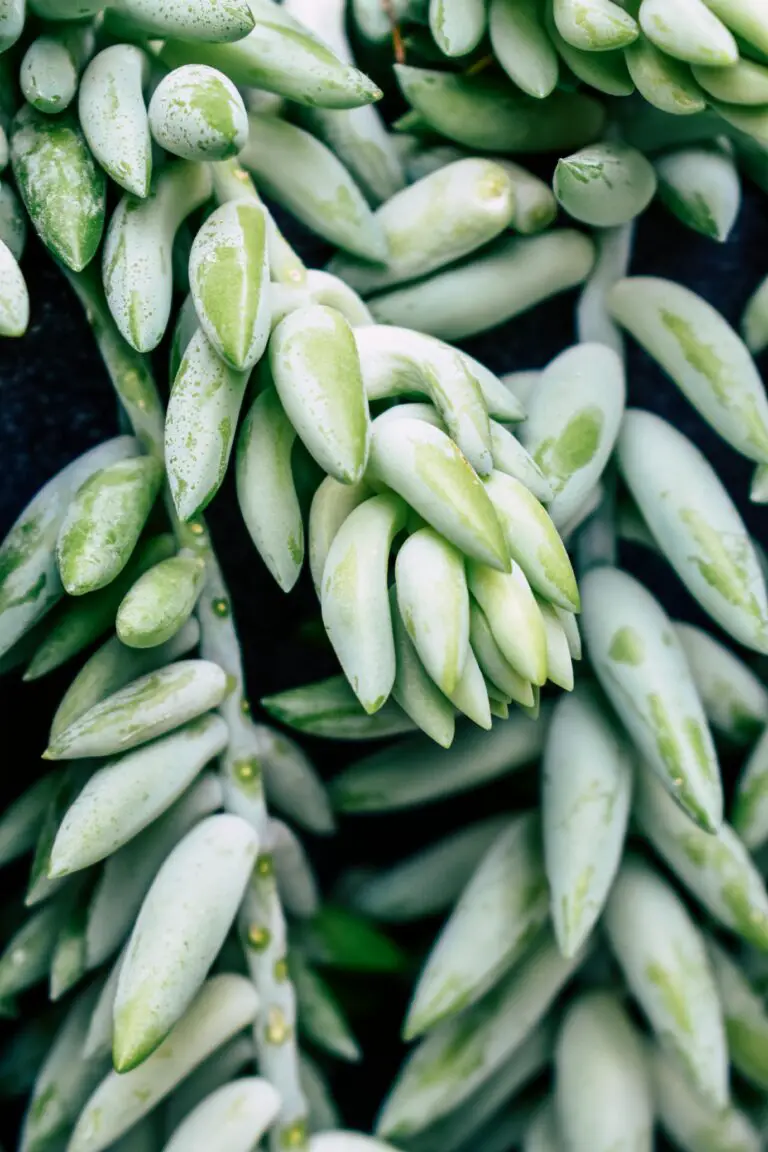
Soil, the unsung hero of gardening, needs to be just right. A well-draining mix akin to a comfortable pair of shoes offers room for roots to breathe and flourish. Think of coarse sand intermingled with organic compost; this is the utopian ground for planting our green friend. Together with a periodic drink of water—when the soil feels more like a parched desert than a moist forest—you’ll see your Sedum Rubrotinctum at its best.
And climate preferences? While these little succulents might not need to ride the tropical winds, they do enjoy a climate that mirrors springtime bliss, where the warmth of the day is balanced by cooler evenings. If you’re slightly off the temperature map, don’t worry—these plants are as adaptable as they are adorable. Bring them indoors, where your love for these plants can bubble over in a controlled environment.
Fascinated by the world of succulents? Make sure to explore other intriguing indoor succulent plants to diversify your collection.
Don’t let your modern home miss out on the conversation starters that these Sedum Rubrotinctum can be, especially when you pair their rubbery, red-tipped foliage with sleek, minimalist decor. Imagine the delightful contrast against a white marble tabletop! So go ahead, give them those ideal growing conditions, and watch your vibrant Sedum Rubrotinctum elevate the charm of your living space.
Propagation and Plant Care
If you’re looking to brighten up your living space with some greenery, Sedum Rubrotinctum, also known as the ‘Jelly Bean Plant’ or ‘Pork and Beans’, is your go-to succulent. Let’s dive into how you can propagate and care for this vibrant plant, ensuring it adds a pop of color to your modern home for years to come.
Let’s Propagate: Make More of These Beauties
All it takes to start your Sedum Rubrotinctum family is a few healthy leaves. Gently twist a leaf from the stem, ensuring it comes away clean without any tearing. Lay the leaves on a dry surface, and allow them to callous over for a couple of days. Once they’re ready, place them atop a well-draining succulent mix, and watch the magic happen. Mist the soil lightly when it’s completely dry—patience is key here. Within a few weeks, tiny pink roots and miniature plants will emerge, itching to grow.
Remember Laura from the office with the stunning succulent collection? She started with just a few leaves of Sedum Rubrotinctum, and now it’s a jungle in there! It’s your turn to be the plant guru among your friends.
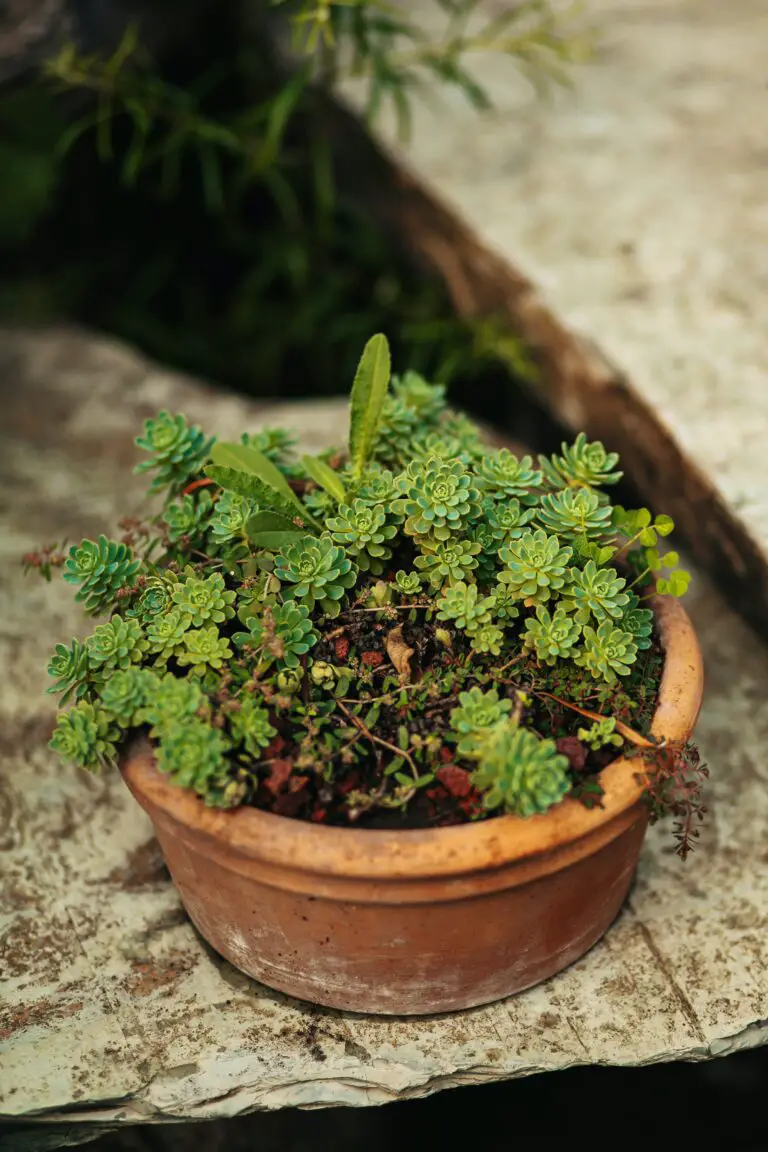
Watering Wisdom: Less is More
Overwatering is the arch-enemy of Sedum Rubrotinctum. These succulents enjoy a good drink, but only when their soil has completely dried out. Imagine them in their natural habitat, thriving on neglect, baking under the sun, and requiring just a drizzle now and then. Follow the ‘soak and dry’ method, fully watering the plant and then allowing the soil to dry out completely before watering again.
Feeding Finesse: A Light Touch
Spring and summer are when your Sedum Rubrotinctum gears up for growth. This is the time to feed it with a balanced, water-soluble fertilizer, diluted to half-strength, once a month. Think of it as a light snack instead of a full meal, providing just enough nutrients to bolster those chubby leaves without overwhelming them.
Prudent Pruning: Shape It Up
When your Sedum Rubrotinctum gets a little too plump and starts flopping over, it’s not just crying for help; it’s time for a trim. Pruning helps maintain an attractive shape and encourages denser growth. Use a clean, sharp pair of scissors or pruning shears, and cut off the overgrown stems just above a leaf node. Don’t throw away those trimmings—recycle them into new plants by following the propagation steps above.
By providing the right care, your Sedum Rubrotinctum won’t just survive; it’ll thrive, becoming a statement piece in your collection. So, roll up your sleeves, and let’s get those hands dirty – in the cleanest way possible, of course!
Common Challenges and Solutions
Thriving in the nooks of modern homes, Sedum Rubrotinctum, commonly known as the Jelly Bean Plant, adds a vibrant touch to indoor greenery with its jelly bean-like foliage. However, even the hardiest succulents have their quirks and quandaries. Let’s dive into the common challenges faced by these succulent aficionados and provide expert solutions to ensure your Jelly Beans remain plump and prosperous.
Combatting Overwatering: The Peril of Generosity
It’s tempting to shower your Sedum Rubrotinctum with love—and water—but excess hydration is a faux pas in the succulent world. The manifestation of generosity often results in wilted, mushy leaves. Unlike other houseplants, the Jelly Bean Plant thrives on neglect in the watering department. Hold your watering can at bay and allow the soil to dry out completely between waterings. Trust in the robust nature of this succulent, as mastering the art of restraint will yield juicy, robust jelly beans.
Fading Foliage: The Light Dilemma
A common spectacle is the loss of the Sedum Rubrotinctum’s vibrant red hue, turning into a pale imitation of its former self. This chameleon-like trait is often due to inadequate lighting. Succulents crave the sun’s embrace, and without it, they become dull and etiolated. To remedy this, introduce your Jelly Bean Plant to a spot where it can bask in at least six hours of indirect sunlight. Watch as the once-faded foliage revives to its radiant red glory, rekindling the fiery spirit of your green companion.
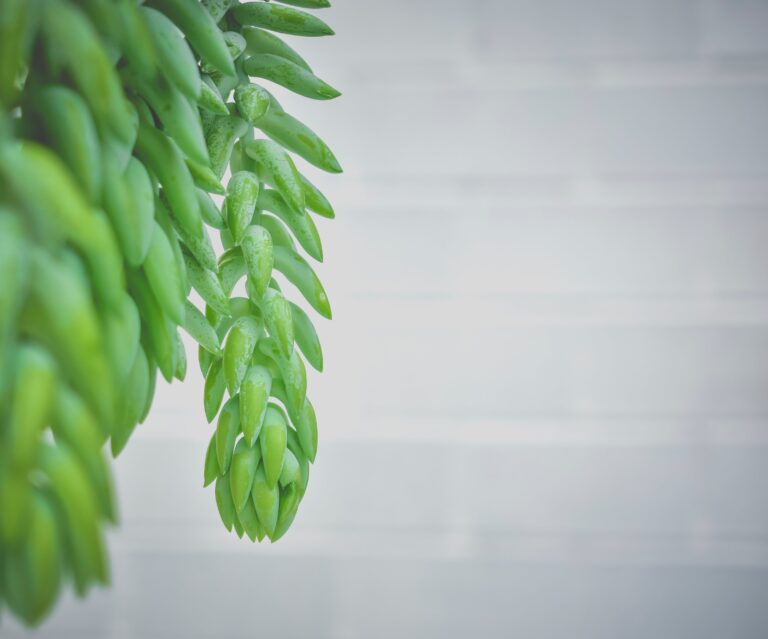
Winter Woes: Chilling to the Bone
As the chill of winter sets in, the Sedum Rubrotinctum can experience a period of dormancy, often mistaken for a sign of demise. Leaves may drop, and growth may stall, but fear not—this is a natural cycle. The key to aiding your Jelly Bean Plant through the colder months is to provide a stable environment. Maintain a consistent temperature, avoiding the icy kiss of drafts and the parching heat of radiators. With the arrival of spring, your patient tending will be rewarded with signs of new growth and vitality.
Pest Patrol: Guarding the Green
Even the tiniest critters find the Jelly Bean Plant irresistible. Mealybugs, spider mites, and aphids can turn your succulent sanctuary into a feeding ground. Regular inspections are your best defense, detecting unwelcome diners before they set up shop. If you discover pests, isolate the affected plant and employ a gentle insecticidal soap or neem oil treatment. A vigilant eye and prompt action will preserve the pristine condition of your Sedum Rubrotinctum’s lustrous leaves.
Encounters with these challenges may test your green thumb, but the solutions breathe simplicity. By understanding and respecting the unique needs of Sedum Rubrotinctum, overcoming obstacles becomes an empowering journey rather than a daunting task. Remember, every challenge is an opportunity to grow alongside your vibrant, succulent friend.
Design Ideas with Sedum Rubrotinctum
Ignite your creativity and bring a splash of drama to your home decor with the vibrant Sedum Rubrotinctum. The fleshy, jelly bean-like leaves with their red-hued tips make this succulent a stand-out choice for modern homes. But how can you integrate this charming little plant into your living spaces to create a natural sanctuary? Let’s dive into some innovative design ideas that celebrate the joy of having this colorful succulent in your everyday surroundings.
Creating Succulent Statements in Living Rooms
Imagine walking into a living room where the green hues of various succulents harmonize with the ruby red pigment of Sedum Rubrotinctum. Use contrasting textures like smooth ceramics or rough hewn stone to house these resilient plants. Cluster different sizes together on a coffee table, or let a large, bountiful pot of Sedum Rubrotinctum stand proudly on a pedestal as a captivating focal point.
Desk Companions for Workspaces
In the world of remote work and home offices, a dash of green can spark joy and creativity. Situate a small pot of Sedum Rubrotinctum next to your laptop, where it demands minimal care but offers a maximum visual boost. Paired with cool, light-colored stones and a sleek, minimalist pot, your desk can transform into a zone of calm productivity.
Catch a glimpse of how to use these succulents stylishly and sustainably through all seasons:
Bathroom Edens with a Pop of Color
Turn your bathroom into a tranquil retreat by introducing Sedum Rubrotinctum into the mix. Nestle it amongst soft mosses or air plants for a lush, terrarium-like effect on a windowsill. The steam from your shower can provide just the right amount of humidity, mimicking the arid environments this succulent thrives in, while adding a vivid contrast to typically neutral bathroom palettes.
Outdoor Accents in Urban Gardens
Don’t limit your imagination to the indoors—Sedum Rubrotinctum can elevate your balcony garden or outdoor patio as well. Mingling amidst rockeries or gracing the top of a green wall, Sedum Rubrotinctum can survive the urban jungle with its drought-resistant superpower. Intersperse with other drought-tolerant plants for an eco-friendly and maintenance-light garden that captivates the senses.
Let these ideas inspire you to craft your very own green haven. Sedum Rubrotinctum isn’t just a plant—it’s a statement piece that can elevate the mundane to the magnificent!
Health and Environmental Benefits
In our fast-paced modern world, it’s essential to find ways to foster a serene environment at home. Enter Sedum Rubrotinctum, the vibrant succulent that’s more than just an eye-catching piece of decor. Known for its plump, jelly bean-like leaves, this succulent offers a host of health and environmental benefits that can transform any living space into a sanctuary of well-being.
Breathe Easier with Natural Air Purification
Plants are nature’s own air purifiers, and Sedum Rubrotinctum is no exception. It plays a pivotal role in absorbing toxins and exhaling fresh oxygen, giving your home air a much-needed detox. Imagine having a natural oxygen bar right in your living room – that’s the magic this succulent brings to the table. Its presence means you’re less likely to breathe in harmful chemicals emitted from electronics and furniture, safeguarding your family’s health.
Stress Reduction on a Windowsill
Stress is the silent thief of joy and health, but Sedum Rubrotinctum offers a simple antidote. Studies have shown that being around greenery can lower stress levels, and keeping a succulent like this can serve as a daily reminder to slow down and appreciate the small wonders of life. Just gazing at its rich, red-tipped leaves can be an instant mood booster, perfect for those moments when you need to de-stress.
A Succulent Solution for Urban Environments
Urbanites rejoice! Whether you’re in a high-rise apartment or a cozy corner home, Sedum Rubrotinctum adapts effortlessly. Its low water requirements and resilience to various light conditions make it a sustainable choice for city living. But it’s not just about easy care—this succulent can actually help combat the urban heat island effect. By absorbing sunlight and heat, it can contribute to cooler, more comfortable living areas, both indoors and out.
There’s a small but significant way each of us can make a big environmental impact, and it starts with choosing plants that are both beautiful and beneficial. Sedum Rubrotinctum, with its lush green foliage accented by hues of red, makes the decision easy. When you add it to your living space, you’re not just decorating; you’re inviting in a natural ally that nurtures your health and the environment—one pot at a time.
Frequently Asked Questions
Curious about how to keep your Sedum Rubrotinctum thriving? You’re not alone! This section is your go-to guide for understanding the ins and outs of nurturing your vibrant succulent. Below, we delve into real-life examples and queries that’ll help you become a pro at caring for this unique plant.
What’s the Ideal Lighting for My Sedum Rubrotinctum?
Just like a sunbather on a golden beach, your Sedum Rubrotinctum loves soaking up the rays. Place it in a spot where it can bask in plenty of sunlight – think bright, indirect light indoors, or a partial shade area if it’s outdoors. But remember, while they love light, too much direct sun can cause sunburn, similar to how we might need sunscreen after hours in the sun!
How Often Should I Water My Jelly Bean Plant?
Imagine your plant is telling you, “Please water me, but only when I’m thirsty!” Overwatering is a no-go. It’s like offering a glass of water to someone who’s just chugged an entire bottle—unnecessary and uncomfortable. Water only when the soil is dry to the touch, imitating a light desert rain.
Is Repotting Necessary?
Think of repotting as moving into a bigger home. Sometimes, your plant’s roots need a new space to continue growing. A good indication it’s time to repot is when you see roots peering out of the pot’s drainage holes or when growth seems to have halted – a clear sign it’s time for a roomier abode.
What Soil Mix Suits Sedum Rubrotinctum Best?
Your Sedum Rubrotinctum prefers living in the equivalent of a sandy beach rather than a muddy swamp. That means well-draining soil that makes water flow through quickly, similar to how sand filters rain on a shoreline. You can buy a succulent mix or make your own with a blend of potting soil, coarse sand, and perlite.
And here’s a visual treat! Dive into this video to get more hands-on tips on caring for your Sedum Rubrotinctum:
Remember, every Sedum Rubrotinctum is as individual as its owner – paying attention to your plant’s signals is key. With the right care and a bit of succulent savvy, your Jelly Bean plant will be a cheerful companion in your modern home, captivating guests with its lively hues and plump leaves.
